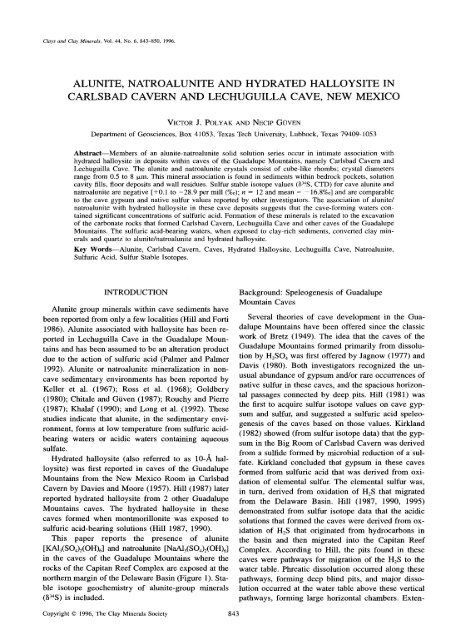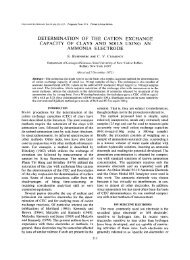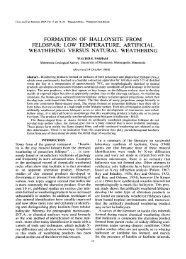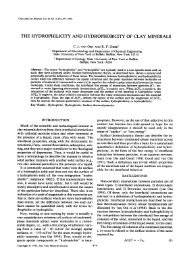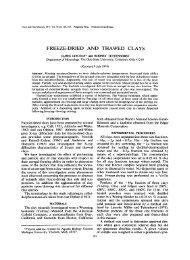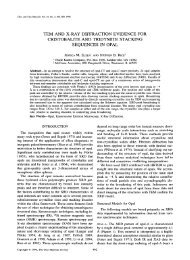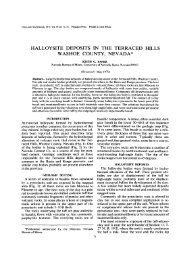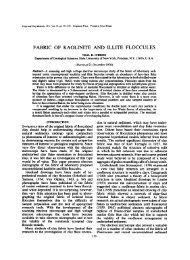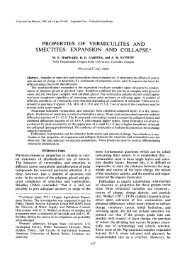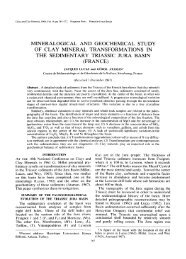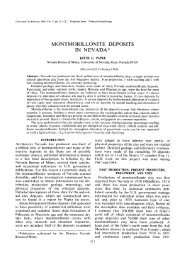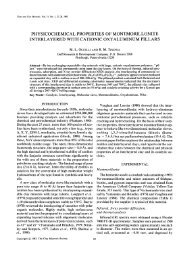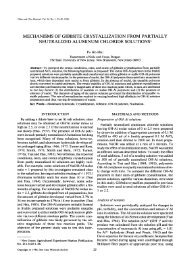t - Clay Minerals Society
t - Clay Minerals Society
t - Clay Minerals Society
You also want an ePaper? Increase the reach of your titles
YUMPU automatically turns print PDFs into web optimized ePapers that Google loves.
<strong>Clay</strong>s and <strong>Clay</strong> <strong>Minerals</strong>, Vol. 44, No. 6, 843-850, 1996.<br />
ALUNITE, NATROALUNITE AND HYDRATED HALLOYSITE IN<br />
CARLSBAD CAVERN AND LECHUGUILLA CAVE, NEW MEXICO<br />
VICTOR J. POLYAK AND NECIP GOVEN<br />
Department of Geosciences, Box 41053, Texas Tech University, Lubbock, Texas 79409-1053<br />
Abstract--Members of an alunite-natroalunite solid solution series occur in intimate association with<br />
hydrated halloysite in deposits within caves of the Guadalupe Mountains, namely Carlsbad Cavern and<br />
Lechuguilla Cave. The alunite and natroalunite crystals consist of cube-like rhombs; crystal diameters<br />
range from 0.5 to 8 p~m. This mineral association is found in sediments within bedrock pockets, solution<br />
cavity fills, floor deposits and wall residues. Sulfur stable isotope values (~345, CTD) for cave alunite and<br />
natroalunite are negative [+0.1 to -28.9 per mill (%o); n = 12 and mean = 16.8%~] and are comparable<br />
to the cave gypsum and native sulfur values reported by other investigators. The association of alunite/<br />
natroalunite with hydrated halloysite in these cave deposits suggests that the cave-forming waters con-<br />
tained significant concentrations of sulfuric acid. Formation of these minerals is related to the excavation<br />
of the carbonate rocks that formed Carlsbad Cavern, Lechuguilla Cave and other caves of the Guadalupe<br />
Mountains. The sulfuric acid-bearing waters, when exposed to clay-rich sediments, converted clay min-<br />
erals and quartz to alunite/natroalunite and hydrated halloysite.<br />
Key Words--Alunite, Carlsbad Cavern, Caves, Hydrated Halloysite, Lechuguilla Cave, Natroalunite,<br />
Sulfuric Acid, Sulfur Stable Isotopes.<br />
INTRODUCTION<br />
Alunite group minerals within cave sediments have<br />
been reported from only a few localities (Hill and Forti<br />
1986). Alunite associated with halloysite has been re-<br />
ported in Lechuguilla Cave in the Guadalupe Moun-<br />
tains and has been assumed to be an alteration product<br />
due to the action of sulfuric acid (Palmer and Palmer<br />
1992). Alunite or natroalunite mineralization in non-<br />
cave sedimentary environments has been reported by<br />
Keller et al. (1967); Ross et al. (1968); Goldbery<br />
(1980); Chitale and Gtiven (1987); Rouchy and Pierre<br />
(1987); Khalaf (1990); and Long et al. (1992). These<br />
studies indicate that alunite, in the Sedimentary envi-<br />
ronment, forms at low temperature from sulfuric acid-<br />
bearing waters or acidic waters containing aqueous<br />
sulfate.<br />
Hydrated halloysite (also referred to as 10-/~ hal-<br />
loysite) was first reported in caves of the Guadalupe<br />
Mountains from the New Mexico Room in Carlsbad<br />
Cavern by Davies and Moore (1957). Hill (1987) later<br />
reported hydrated halloysite from 2 other Guadalupe<br />
Mountains caves. The hydrated halloysite in these<br />
caves formed when montmorillonite was exposed to<br />
sulfuric acid-bearing solutions (Hill 1987, 1990).<br />
This paper reports the presence of alunite<br />
[KA13(SO4)2(OH)6 ] and natroalunite [NaA13(SO4)2(OH)6 ]<br />
in the caves of the Guadalupe Mountains where the<br />
rocks of the Capitan Reef Complex are exposed at the<br />
northern margin of the Delaware Basin (Figure 1). Sta-<br />
ble isotope geochemistry of alunite-group minerals<br />
(~34S) is included.<br />
Copyright 9 1996, The <strong>Clay</strong> <strong>Minerals</strong> <strong>Society</strong> 843<br />
Background: Speleogenesis of Guadalupe<br />
Mountain Caves<br />
Several theories of cave development in the Gua-<br />
dalupe Mountains have been offered since the classic<br />
work of Bretz (1949). The idea that the caves of the<br />
Guadalupe Mountains formed primarily from dissolu-<br />
tion by H2SO4 was first offered by Jagnow (1977) and<br />
Davis (1980). Both investigators recognized the un-<br />
usual abundance of gypsum and/or rare occurrences of<br />
native sulfur in these caves, and the spacious horizon-<br />
tal passages connected by deep pits. Hill (1981) was<br />
the first to acquire sulfur isotope values on cave gyp-<br />
sum and sulfur, and suggested a sulfuric acid speleo-<br />
genesis of the caves based on those values. Kirkland<br />
(1982) showed (from sulfur isotope data) that the gyp-<br />
sum in the Big Room of Carlsbad Cavern was derived<br />
from a sulfide formed by microbial reduction of a sul-<br />
fate. Kirkland concluded that gypsum in these caves<br />
formed from sulfuric acid that was derived from oxi-<br />
dation of elemental sulfur. The elemental sulfur was,<br />
in turn, derived from oxidation of H2S that migrated<br />
from the Delaware Basin. Hill (1987, 1990, 1995)<br />
demonstrated from sulfur isotope data that the acidic<br />
solutions that formed the caves were derived from ox-<br />
idation of H2S that originated from hydrocarbons in<br />
the basin and then migrated into the Capitan Reef<br />
Complex. According to Hill, the pits found in these<br />
caves were pathways for migration of the H2S to the<br />
water table. Phreatic dissolution occurred along these<br />
pathways, forming deep blind pits, and major disso-<br />
lution occurred at the water table above these vertical<br />
pathways, forming large horizontal chambers. Exten-
844 Polyak and Gtiven <strong>Clay</strong>s and <strong>Clay</strong> <strong>Minerals</strong><br />
t \i<br />
"- ""J "~"~'i % I<br />
"~.. j ,~, ,.-.'%,,~ I~, Carlsbad ,<br />
- / "~. . ~ Cavern 'I~_ \ ~ w ,<br />
I<br />
_Guadalupe ~,:..-- ~ / \ MEXICO '. TEXAS<br />
Mountains " rd----~-~' ~ i I<br />
"; I / , ~ o White City \ I<br />
:,~. I I.~-~ Carlsbad Caverns I ~ I<br />
". I .,,m National Park I ~ I<br />
,,, @~, ,, I ~r, I i<br />
10km ~'~ .e "y ~ ~oRoswell f ' ~<br />
. ~ Carisbad I ~, Midland<br />
,: (<br />
----~ElPaso "( Delawere \ \ t<br />
t 100 mi k t- ~"~ """~<br />
N ~, "-<br />
/<br />
Figure 1. Map showing location of study area in relation to the Permian Delaware Basin.<br />
sive gypsum deposits within these caves were byprod-<br />
ucts of the reaction of H2SO4 with carbonate bedrocks.<br />
Hill (1990) suggested that the isotopically-light sulfur<br />
isotope signatures (~345) of the gypsum and native sul-<br />
fur in these caves are evidence that the large passages<br />
were formed primarily by H2SO4 derived from bio-<br />
chemical fractionations of sulfur in the basin.<br />
METHODS<br />
X-ray diffraction (XRD) of random powders and<br />
suspended mounts were performed using a Philips No-<br />
relco diffractometer operated at 40 kV and 20 mA with<br />
nickel-filtered CuKet radiation. Characteristic X-ray<br />
spectra were obtained on single crystals of alunite and<br />
clays using energy dispersive X-ray spectroscopy (EDS)<br />
interfaced to a JEOL JEM-100CX electron micro-<br />
scope. Transmission electron microscopy (TEM) and<br />
scanning electron microscopy (SEM) were used to<br />
study mineral morphology.<br />
Unit-cell parameters were determined using the in-<br />
dexing and least-squares powder diffraction program<br />
by Appleman and Evans (1973) revised for the PC by<br />
Benoit (1987). Stable isotope analyses were provided<br />
by Geochron Laboratories, 711 Concord Avenue,<br />
Cambridge, Massachusetts 02138.<br />
Samples were collected from the Big Room, Gua-<br />
dalupe Room, Boneyard (near lunchroom), New Mex-<br />
ico Room, Lower Devil's Den and Lower Cave in<br />
Carlsbad Cavern. Samples were collected from Apri-<br />
cot Pit, Boulder Falls, Glacier Bay, Lake LeBarge, The<br />
Great Beyond and Tinsel Town in Lechuguilla Cave.<br />
Other alunite/natroalunite and hydrated halloysite sam-<br />
pies were collected from Endless, Hell Below, Virgin<br />
and Cottonwood caves.<br />
DEPOSITIONAL ENVIRONMENT<br />
In all of the caves studied, alunite group minerals<br />
and hydrated halloysite are found together in 4 depo-<br />
sitional settings: 1) bedrock pockets, 2) solution cavity<br />
fills, 3) floor deposits and 4) bedrock wall residues<br />
(Figure 2). Bedrock pockets are usually less than 50<br />
cm in diameter and are characterized by the occur-
Vol. 44, No. 6, 1996 Alunite, natroalunite and hydrated halloysite in Carlsbad Cavern 845<br />
lm<br />
WALL i<br />
BEDROCK]<br />
SOLUTION CAVITIES<br />
~////~OR DEPOSITS<br />
Figure 2. Idealized section of cave passage showing the 4<br />
depositional settings in which alunite and natroalunite are<br />
found.<br />
rence of iron- and manganese-rich minerals that gen-<br />
erally have a distinct black appearance. Bluish white<br />
nodules of hydrated halloysite are occasionally ob-<br />
served in this setting, as well. The bedrock pocket set-<br />
ting is the most characteristic for sediments containing<br />
hydrated halloysite and ahinite group minerals. Solu-<br />
tion cavities, particularly in Carlsbad Cavern, are<br />
sometimes filled or partially filled with laminated silty<br />
clay-rich sediment. Numerous cm-sized solution cav-<br />
ities give bedrock in the Green <strong>Clay</strong> Room a "Swiss<br />
cheese" appearance. This network of cavities, called<br />
"spongework" (Hill 1987; Ford and Williams 1992),<br />
can form complex 3-dimensional mazes of cave pas-<br />
sages. These solution cavity fills sometimes contain<br />
hydrated halloysite and alunite group minerals. Floor<br />
deposits that contain hydrated halloysite and alunite<br />
group minerals range in size from 100 m 2.<br />
Floor deposits of this type in Lower Cave and the Big<br />
Room of Carlsbad Cavern are piled silt and clay layers<br />
(not to be confused with the extensive brown silt de-<br />
posits of the cavern). These deposits contain fragments<br />
of red silt, brown and gray clay and nodules of hy-<br />
drated halloysite, and appear to have fallen from the<br />
ceiling bedrock pockets and solution cavities located<br />
10 to 100 m above. In the New Mexico Room and in<br />
Endless Cave, floor deposits are dominated by hydrat-<br />
ed halloysite. Wall residues, black in color due to as-<br />
sociated manganese minerals, contain alunite, natroal-<br />
unite and hydrated halloysite and are most apparent in<br />
Lechuguilla Cave. Although areas throughout much of<br />
the larger caves still exhibit outcrops of these materi-<br />
als, in many places they are mostly covered by later<br />
depositions of gypsum blocks and crusts, or carbonate<br />
crusts, flowstones and dripstones.<br />
Mineralogy<br />
RESULTS<br />
Other minerals accompanying hydrated halloysite<br />
and K- or Na-alunite vary in the 4 settings described<br />
previously. Smectite, todorokite, goethite, detrital<br />
quartz and occasionally gibbsite occur with hydrated<br />
halloysite and the alunites in bedrock pockets. Hy-<br />
drated halloysite and alunite group minerals are asso-<br />
ciated with silt-sized quartz grains, smectite and ka-<br />
olinite in floor deposits and solution cavity fills. Wall<br />
residues contain nordstrandite, goyazite, goethite, il-<br />
lite, dickite and manganese minerals such as rancieite.<br />
Todorokite, rancieite, lithophorite, quartz, poorly crys-<br />
talline or amorphous iron oxide and an aluminum hy-<br />
droxide mineral in wall residues of Lechuguilla Cave<br />
were reported by Modreski (1989) and Cunningham<br />
et al. (1995). Hydrated halloysite and alunite-group<br />
minerals are usually associated in all of these settings.<br />
Hydrated halloysite is present in caves of the Gua-<br />
dalupe Mountains mostly as vitreous to waxy nodules<br />
or as moist powder. The color of the hydrated halloy-<br />
site is white, bluish white, bluish green, red, yellow,<br />
brown and pink. The mineral sometimes occurs as a<br />
pure floor deposit, as in the middle maze of Endless<br />
Cave and the New Mexico Room of Carlsbad Cavern.<br />
Halloysites from caves of the Guadalupe Mountains<br />
were identified as the hydrated (10-,~) phase, with the<br />
possible exception of a partially dehydrated sample<br />
(metahalloysite) from Cottonwood Cave. Transmission<br />
electron micrographs of hydrated halloysite crystals<br />
exhibit typical tubular morphology. Crystal size and<br />
morphology are similar in all samples; tube dimen-<br />
sions are variable in their length and consistent in their<br />
width, Bailey (1993) noted that changes in the mor-<br />
phology and dimensions of the hydrated halloysite can<br />
be related to the chemical composition of the tubes;<br />
for instance, long tubes favor an A1203 content of 46<br />
to 50% (Al-rich) and an Fe203 content of < 1 wt%.<br />
Hydrated halloysites from Guadalupe caves exhibit tu-<br />
bular crystal morphology of variable length. Average<br />
tube length and width are 0.28 and 0.06 p~m, respec-<br />
tively, with some tubes exceeding 1 p,m in length. Iron<br />
was not detected in the halloysite found in these cave<br />
deposits.<br />
Ahinite or natroalunite is generally found dissemi-<br />
nated within waxy nodules of hydrated halloysite, or<br />
concentrated in white, light brown and pink pasty or<br />
powdery nodules. At the Under-The-Cross in the Big<br />
Room in Carlsbad Cavern, alunite occurs in reddish<br />
brown clay-rich floor sediment as mm-sized white<br />
pods. In other deposits, some pods of alnnite are up<br />
to several cm in size and are almost pure except for<br />
minor amounts of hydrated halloysite. Natroalunite
846 Polyak and Giiven <strong>Clay</strong>s and <strong>Clay</strong> <strong>Minerals</strong><br />
Figure 3. SEM image of cube-like alunite crystals.<br />
and alunite crystals are cube-like rhombs that range in<br />
diameter from 0.5 to 8 txm (Figure 3) and are inti-<br />
mately associated with hydrated halloysite (Figure 4).<br />
Mole percent of natroalunite in the samples was es-<br />
timated by:<br />
XNa = (17.331 - c)/0.635 [1]<br />
where c is the c-axis dimension (,~) of the alunite as<br />
determined by XRD data (Stoffregen and Alpers 1992).<br />
Samples analyzed represent an almost complete solid<br />
solution between alunite and natroalunite end-mem-<br />
bers from approximately 5 to 86 mol% natroalunite.<br />
Figure 4. TEM photograph of an alunite crystal and inti-<br />
mately associated halloysite tubes. Bar length = 1.0 ~m.<br />
Unit cell parameters and calculated mol% natroalunite<br />
are listed in Table 1. A sample of alunite from the New<br />
Mexico Room in Carlsbad Cavern was calculated to<br />
be 52 tool% natroalunite by the XRD method and 46<br />
mol% natroalunite by inductively coupled plasma<br />
(ICP) analysis. Strontium and phosphorus detected in<br />
many samples represent a minor intergrowth of goy-<br />
azite. For example, ICP and EDS results of the New<br />
Mexico Room sample provide the chemical composi-<br />
tion (K0.z9Na0.46Sr0.05) A13(SO4)1.91 (PO4)0.09(on)6 and<br />
indicate the presence of K, Na and Sr as the alkali<br />
Table 1. List of alunite samples, occurrence, unit cell parameters, mol% natroalunite and ~348 (CTD) values in per mill.<br />
MoI%<br />
Volume natro- ~34S<br />
Sample Cave a-axis (A) c-axis (A) (/~3) alunite (CTD)<br />
92015 Carlsbad (NM Room) 6.985(2) 17.00(2) 718.3(1) 52 ndw<br />
93009 Carlsbad (Big Room) 6.992(2) 17.14(2) 725.4(6) 30 -22.7<br />
93011 Carlsbad (Big Room) 6.993(8) 17.18(8) 727(2) 24 - 18.1<br />
93012 Carlsbad (Big Room) 6.991(4) 17.14(2) 725(1) 30 nd<br />
93013 Carlsbad (Big Room) 6.985(2) 17.26(1) 729.3(6) 11 nd<br />
93014 Carlsbad (Boneyard) 6.989(4) 17.01(7) 720(2) 51 -6.7<br />
93018 Lechuguilla (Gr. Beyond) 7.004(3) 17.18(1) 729.7(5) 25 -28.7<br />
93020 Lechuguilla (L. LeBarge) 7.007(5) 17.03(5) 724(1) 47 nd<br />
93041 Carlsbad (Gr. <strong>Clay</strong> Room) 6.996(2) 17.20(2) 728.8(8) 21 - 14.0<br />
94006 Carlsbad (Guad. Room) 6.994(2) 16.785(2) 711.0(3) 86 -27.1<br />
94017 Cottonwood (Balcony) 7.007(7) 17.21(2) 732(2) 19 0.01<br />
94034 Lechuguilla (L. LeBarge) 6.983(5) 17.04(9) 720(3) 46 -21.4<br />
94042b Carlsbad (NM Room) 7.004(3) 17.12(8) 727(3) 33 -9.8<br />
94042w Carlsbad (NM Room) 6.993(5) 17.30(3) 733(2) 5 -22.2<br />
94043 Carlsbad (NM Room) 7.003(3) 16.99(2) 721.6(9) 54 -19.4<br />
94054 Virgin 6.983(3) 17.27(1) 729.6(7) 9 nd<br />
Natroalunitet 6.9786(7) 16.696(3) 704.2(2) 100<br />
Alunitet 6.981(1) 17.331(4) 731.5(2) 0<br />
Hydrodium 7.005(2) 17.114(7) 727.2(4)<br />
Alunitet<br />
Goyazite:~ 7.015(3) 16.558(6)<br />
t Unit cell dimensions for natroalunite, alunite and hydronium alunite used here as end members were taken from Stoffregen<br />
and Alpers (1992).<br />
$ The goyazite unit cell used here as an end member was taken from Kato (1987).<br />
w nd = not determined.
Vol. 44, No. 6, 1996 Alunite, natroalunite and hydrated halloysite in Carlsbad Cavern 847<br />
~ 7<br />
7.02 5<br />
7.01<br />
. 0 0<br />
6.99<br />
'~ 6.98<br />
6.97<br />
9 "- goyazite<br />
~natroalunite o<br />
o / hTronium altmitr<br />
6.96<br />
16.5 16.7 16.9 17.1 17.3 17.5<br />
e-axis (Angstroms)<br />
(3<br />
o<br />
(3<br />
o o ~176 9 alunite<br />
Figure 5. Unit-cell parameters of alunite and natroalunite<br />
found in caves of the Guadalupe Mountains in relation to<br />
goyazite mid alunite-group end members. Alunite-group end-<br />
member data taken from Stoffregen and Alpers (1992), and<br />
goyazite end-member data taken from Kato (1987).<br />
exchangeable cations. Iron is lacking as a substitute<br />
for AI. The absence of iron explains the scarcity of<br />
jarosite, although jarosite has been identified as trace<br />
constituents of 2 cave deposits from the study area.<br />
Unit-cell dimensions of the cave alunite and natroal-<br />
unite are plotted in Figure 5 against end-member unit-<br />
cell dimensions reported for alunite, natroalunite, hy-<br />
dronium alunite and goyazite. These data seem to in-<br />
dicate the presence of hydronium alunite, as well.<br />
Stable Isotope Data<br />
Sulfur isotope values of alunite/natroalunite from<br />
Carlsbad Cavern, Lechuguilla Cave and Cottonwood<br />
Cave were determined for 12 samples. Values of ~345<br />
for the alunite-group minerals ranged from +0.1%o to<br />
-28.7%0 (CDT) with a mean of -16.8%o. The highest<br />
~34S value for alunite was +0.1%o from Cottonwood<br />
Cave. The mean ~34S values for alunite-group minerals<br />
from Carlsbad Cavern and Lechuguilla Cave were<br />
-17.5%o and -26.2%o, respectively. These values<br />
compare well with Kirkland (1982), Hill (1987) and<br />
Spirakis and Cunningham (1992) for gypsum and na-<br />
tive sulfur. Kirkland (1982) and Hill (1987, 1990) re-<br />
ported ~345 values from Carlsbad Cavern with a mean<br />
of -18.8%o, whereas Spirakis and Cunningham (1992)<br />
reported ~34S values from Lechuguilla Cave native sul-<br />
fur and gypsum with a mean of -23.74%o. Also, Hill<br />
(1987) reported the heaviest sulfur isotope values from<br />
Cottonwood Cave in gypsum, as was the case for al-<br />
unite from that cave. Mole percents of natroalunite in<br />
the samples are also plotted against sulfur isotope val-<br />
ues (Figure 6). The sulfur isotope data are listed in<br />
Table 1 and Table 2.<br />
DISCUSSION<br />
Berthier (1826) was the first to describe halloysite<br />
and reported it as blue material from solution cavities<br />
in limestone (associated with alunite); the type locality<br />
0<br />
-5<br />
-10<br />
~S -15<br />
-20<br />
-25<br />
-30<br />
o<br />
E]<br />
D<br />
Figure 6. Mole percent natroalunite for alunite-group rainerals<br />
in samples from caves in the Guadalupe Mountains<br />
compared to 5348 (CTD) values per mill (%0) for those samples.<br />
D<br />
D<br />
20 40 60 80 100<br />
tool % natr0alunite<br />
was a zinc and iron mining district in Liege, Belgium.<br />
Other early reports of halloysite were also from solu-<br />
tion cavities in limestone associated with alunite (Ross<br />
and Kerr 1935). The depositional settings observed for<br />
this mineral assemblage within caves of the Guadalupe<br />
Mountains are apparently characteristic.<br />
Alunite-group minerals associated with kaolinite<br />
group minerals such as hydrated halloysite are known<br />
to form in various acid-sulfate environments (Rye et<br />
al. 1992). Ambers and Murray (1995) summarized that<br />
the prerequisite for the origin of halloysite-rich indi-<br />
anaite was the interaction of clay minerals with H2SO4-<br />
bearing vadose solutions, Hill (1987, 1990) suggested<br />
that hydrated halloysite formed in Guadalupe Moun-<br />
tain caves by the transformation of montmorillonite<br />
during excavation of the large caves by sulfuric acid.<br />
Thus, the occurrence of alunite/natroalunite with hy-<br />
drated halloysite in Carlsbad Cavern, Lechuguilla and<br />
other Guadalupe caves is significant because it further<br />
supports this theory of cave development by H2SO4-<br />
bearing solutions.<br />
H611er (1967) postulated that alunite can be pro-<br />
duced from illite. Goldbery (1980), Chitale and Giiven<br />
(1987) and Rouchy and Pierre (1987) summarized that<br />
ahinite in the sedimentary environment forms from the<br />
reaction between H2SO 4 and clay minerals. According<br />
to Chitale and Giiven (1987), natroalunite formed from<br />
the reaction of kaolinite with H2SO4 in laterite. In<br />
caves of the Guadalupe Mountains, alunite and hy-<br />
drated halloysite formed in a similar way, from the<br />
reaction of H2SO4 with clay minerals.<br />
Throughout the Guadalupe Mountains, the most<br />
abundant clay minerals available prior to cave devel-<br />
opment were probably illite, mica and dickite/kaolin-<br />
ite, as indicated by bedrock weathering residues (Po-<br />
lyak and Gtiven 1995) and insoluble residues of vari-<br />
ous samples of dolostones. However, deposits of green<br />
and brown, smectite-rich sediments are also found in<br />
solution cavities and early cave passages prior to de-
848 Polyak and Gtiven <strong>Clay</strong>s and <strong>Clay</strong> <strong>Minerals</strong><br />
Table 2. Comparison of ~34S (CTD) values for alunite, gypsum and native sulfur from caves of the Guadalupe Mountains.<br />
Alunite ~3nS values Gypsum and sulfur ~34S values<br />
Cave and location (this study)~ (other studies)t<br />
Carlsbad Cavern<br />
Big Room - 18.1, - 22.7<br />
Boneyard<br />
Green <strong>Clay</strong> Room<br />
Guadalupe Room<br />
New Mexico Room<br />
Lechuguilla Cave<br />
Apricot Pit -28.6<br />
Chandelier Ballroom<br />
Ghost Town<br />
Great Beyond -21.4<br />
Lake LeBarge -28.7<br />
Void<br />
Cottonwood Cave<br />
Upper Gypsum Passage +0.1<br />
Lower Gypsum Passage<br />
-6.7<br />
-14.0<br />
-27.1<br />
-9.8, - 19.4, -22.2<br />
- 13.9, - 17.6, - 19.0, - 19.9, -21.1 (Hill 1987)<br />
-20.0 (Hill 1987) ns~:<br />
-15.0, -15.2, -18.3, -18.9, -19.3, -22.0<br />
1982)<br />
(Kirkland<br />
-25.55 (Spirakis and Cunningham 1992)<br />
-21.19, -22.96 (Spirakis and Cunningham 1992) ns:~<br />
-23.51, -25.80 (Spirakis and Cunningham 1992) ns$<br />
+5.0 (Hill 1987)<br />
-0.8 (Hill 1987)<br />
-14.6 (Hill 1987) ns~<br />
t All values are reported as per mill (%0) relative to Canyon Diablo Triolite.<br />
ns = sulfur isotope values derived from native sulfm:<br />
velopment of the major cave passages in Carlsbad<br />
Cavern (Hill 1987). The green clay (montmorillonite)<br />
deposits were partially converted to hydrated halloy-<br />
site by interaction with H2SO4 (Hill 1987). Evidence<br />
of this conversion is very convincing in the Green<br />
<strong>Clay</strong> Room of Lower Cave, where white deposits of<br />
hydrated halloysite and alunite were noted as constit-<br />
uents of reaction rims around smectite clay sediment<br />
filling small solution cavities (Figure 7). The green<br />
clay sediment consists of silt-sized quartz grains, di-<br />
octahedral smectite, illite, palygorskite and kaolinite.<br />
The product of the conversion (the white "rim") con-<br />
sists of hydrated halloysite, alunite and, usually, lesser<br />
amounts of quartz and smectite. The absence of illite<br />
and palygorskite and a decrease in the amount of<br />
quartz and smectite indicate that smectite, illite and<br />
Smectite-Rich Sediment 5 em<br />
Alunite and Hydrated Halloysite<br />
Figure 7. Idealized sketch showing the degrees of alteration of smectite-rieh sediment to alunite and hydrated halloysite in<br />
solution cavity fills. The various degrees of alteration were observed in the Green <strong>Clay</strong> Room of Carlsbad Cavern.
Vol. 44, No. 6, 1996 Alunite, natroalunite and hydrated halloysite in Carlsbad Cavern 849<br />
palygorskite were converted to hydrated halloysite and<br />
alunite with quartz usually surviving the reaction.<br />
Abundant green clay deposits, however, have thus far<br />
only been reported in Carlsbad Cavern, yet alunite and<br />
hydrated halloysite have been found in several Gua-<br />
dalupe caves. This setting, where smectite-rich depos-<br />
its have filled solution cavities, is present only in<br />
Carlsbad Cavern. In the other settings, hydrated hal-<br />
loysite and alunite group minerals most likely formed<br />
from the reaction of acidic solutions with mica, illite<br />
and dickite/kaolinite, the clay minerals that are prob-<br />
ably more available than smectite in the rocks of the<br />
Capitan Reef Complex in the study area.<br />
Isotopically light sulfur as HzS was probably gen-<br />
erated by sulfur-reducing bacteria from sulfate solu-<br />
tions produced by dissolution of anhydrite and gypsum<br />
of the Castile Formation in the basin (Hill 1987, 1990,<br />
1995). The isotopically light sulfur was the ultimate<br />
source of sulfur for gypsum blocks and rinds and for<br />
native sulfur within the caves of the Guadalupe Moun-<br />
tains (Hill 1987, 1990, 1995). We suggest that the K-<br />
and Na-alunite associated with hydrated halloysite and<br />
having the same g34S values as the cave gypsum were<br />
also byproducts of the reaction of sulfuric acid with<br />
the rocks of the Capitan Reef Complex.<br />
An H2SO 4 cave genesis somewhat similar to that<br />
proposed for caves of the Guadalupe Mountains was<br />
described by Van Everdingen et al. (1985) for small<br />
caves located within a travertine deposit in Canada.<br />
They concluded that the caves were partly developed<br />
by HzSO4 formed by oxidation/hydrolysis of H2S es-<br />
caping from spring water. Gypsum crusts forming sub-<br />
aerially on the cave wails by reaction of H2SOa-bear-<br />
ing condensate with calcite resulted in 834S values of<br />
-5.2 to -12%o; these values reflect the microbiolog-<br />
ical reduction of dissolved sulfate in the spring waters.<br />
This was indicated by the 834S values of -1.4 to<br />
-12.0%o of the HS in the spring water and HzS in<br />
the cave air. Van Everdingen et al. (1985) reported ~34S<br />
values of +25.4 to +26.7%o for sulfate ions in spring<br />
water and ~345 values of +26.5%o for sulfate in inor-<br />
ganic gypsum within the travertine. Study of the Ca-<br />
nadian travertine caves provide a "mini" model for<br />
showing the process of microbial reduction of dis-<br />
solved sulfates and the resultant negative 834S values.<br />
Pisarowicz (1994) described a process in a cave in<br />
Mexico where biochemical fractionation of sulfur is<br />
taking place and yielding cave gypsum with ~345 val-<br />
ues similar to the gypsum and alunite found in the<br />
caves of the Guadalupe Mountains. Alunite and na-<br />
troalunite, like gypsum, are sulfates and should inherit<br />
the same ~345 values if they mineralized together from<br />
the same solutions.<br />
Buck et al. (1994) described and categorized differ-<br />
ent types of gypsum deposits that form subaqueously<br />
and subaerially as byproducts during H2S-HzSO4 spe-<br />
leogenesis. From the studies of Van Everdingen et al.<br />
(1985) and Buck et al. (1994), it is obvious that ~34S<br />
values (coupled with ~180 values) determined for care-<br />
fully selected gypsum deposits could provide more de-<br />
tailed information about the origin of the cave gypsum<br />
as well as the solutions responsible for H2S-H2SO4<br />
speleogenesis. The same will apply for the study of<br />
alunite group minerals found in these caves. Alunite,<br />
however, can provide much more information because<br />
stable isotope data can be extracted from hydrogen and<br />
oxygen of the hydroxide, oxygen of the sulfate and<br />
sulfur of the sulfate (Wasserman et al. 1990; Rye et<br />
al. 1992). In addition to the stable isotope information,<br />
radiometric ages can be determined from the potassi-<br />
um and argon in the alunite (Bird et al. 1990; Was-<br />
serman et al. 1990; Rye et al. 1992). Stoffregen et al.<br />
(1994), however, caution that fine-grained alunite can<br />
undergo limited alkali exchange at surficial tempera-<br />
tures which would therefore alter their radiometric<br />
ages.<br />
CONCLUSION<br />
An assemblage of alunite group minerals and hy-<br />
drated halloysite has been found in cave sediments<br />
within bedrock pockets, floor deposits, solution cavity<br />
fills and wall residues. These minerals are generally<br />
indicators of an acidic environment in which sulfuric<br />
acid is present. The ~345 (CTD) values for the natroal-<br />
unite and alunite are similar to ~34S values for gypsum<br />
and native sulfur in these caves that have been previ-<br />
ously reported by other investigators. Natroalunite/al-<br />
unite and hydrated halloysite mineralized in caves of<br />
the Guadalupe Mountains through reaction of clay<br />
minerals with H2SO4 during the excavation of carbon-<br />
ate rocks that formed the large cave passages.<br />
ACKNOWLEDGMENTS<br />
The authors thank R. Turner and K. Glover of the USDA<br />
Forest Service; J. Goodbar of the US Bureau of Land Man-<br />
agement; and D. Pate and J. Richards of the Carlsbad Caverns<br />
National Park for the obtaining of collection permits and ar-<br />
rangement of field trips. We are grateful to B. L. Allen, De-<br />
partment of Plant and Soil Science at Texas Tech University;<br />
C. A. Hill, consulting geologist in Albuqtzerque; H. Karlsson,<br />
Department of Geosciences at Texas Tech University; M. Lee,<br />
Mobile R. & D. Company in Dallas; A. N. Palmer and M. V.<br />
Palmer, Department of Earth Sciences at the State University<br />
of New York College at Oneonta; and an anonymous review-<br />
er for his or her review of this manuscript and suggestions.<br />
We thank C. Mosch and M. Goar for their help on many field<br />
trips. We also express appreciation to C. Belski, H. Burgess,<br />
J. Cochran, J. Ivy, B. Jennings, R. Knapp, K. Sisson and M.<br />
Wallace for field assistance. We also appreciate J. C. Cok-<br />
endolpher for helping to modify Figure 1. This study was<br />
partly funded by a grant from the National Speleological So-<br />
ciety. Stable isotope analyses were awarded to VJP by Geo-<br />
chron Laboratories.<br />
REFERENCES<br />
Ambers CR Murray HH. 1995. The role of carbonate bed-<br />
rock in the formation of indianaite halloysitic clays. Indiana
850 Polyak and Gtiven <strong>Clay</strong>s and <strong>Clay</strong> <strong>Minerals</strong><br />
Geological Survey Bulletin 65. Bloomington, IN: Indiana<br />
University. 29 p.<br />
Appleman DE, Evans HT. 1973. Job 9214: Indexing and<br />
least-squares refinement of powder diffraction data. US Geo-<br />
logical Survey. Computer contribution 20. US National<br />
Technical Information Service. Document PB2-16188.65 p.<br />
Bailey SW. 1993. Review of the structural relationships of<br />
the kaolin minerals. In: Murray HH, Bundy WM, Harvey<br />
CC, editors. Kaolin genesis and utilization. Boulder, CO:<br />
The <strong>Clay</strong> <strong>Minerals</strong> <strong>Society</strong>. p 25-42.<br />
Benoit PH. 1987. Adaption to microcomputer of the Apple-<br />
man-Evans program for indexing and least-squares refine-<br />
ment of powder-diffraction data for unit-cell dimensions.<br />
Am Mineral 72:1018-1019.<br />
Berthier R 1826. Analyse de l'hatloysite. Ann Chim Phys<br />
32:332-334.<br />
Bird MI, Chivas AR, McDougall I. 1990. An isotopic study<br />
of surficial alunite in Australia: 2. Potassium-argon geo-<br />
chronology. Chem Geol 80:133-145.<br />
Bretz JH. 1949. Carlsbad Caverns and other caves of the<br />
Guadalupe block, New Mexico. J Geol 57:447-463.<br />
Buck MJ, Ford DC, Schwarcz HE 1994. Classification of<br />
cave gypsum deposits derived from oxidation of H2S. In:<br />
Sasowsky ID, Palmer MV, editors. Breakthroughs in karst<br />
geomicrobiology and redox geochemistry. Special publi-<br />
cation 1, Symposium of the Karst Waters Institute; 1984<br />
Feb. 16-19; Colorado Springs, CO. Charles Town, WV:<br />
Karst Waters Inst. p 5-9.<br />
Chitale DV, Gtiven N. 1987. Natroalunite in a laterite profile<br />
over Deccan Trap Basalts at Matanumad, Kutch, India.<br />
<strong>Clay</strong>s <strong>Clay</strong> Miner 35:196-202.<br />
Cunningham KI, Northup DE, Pollastro WG, LaRock EJ.<br />
1995. Bacteria, fungi and biokarst in Lechuguilla Cave,<br />
Carlsbad Caverns National Park, New Mexico. Environ<br />
Geol 25:2-8.<br />
Davies WE, Moore GW. 1957. Endellite and hydromagnesite<br />
from Carlsbad Caverns. Nat Speleol Soc Bull 19:24-27.<br />
Davis D. 1980. Cavern development in the Guadalupe Moun-<br />
tains: a critical review of recent hypotheses. Nat Speleol<br />
Soc Bull 42:42-48.<br />
Ford DC, Williams PW. 1992. Karst geomorphology and hy-<br />
drology. New York: Chapman and Hall. 601 p.<br />
Goldbery R. 1980. Early diagenetic, Na-alunite in Miocene<br />
algal mat intertidal facies, Ras Sudar, Sinai. Sedimentology<br />
27:189-198.<br />
Hill CA. 1981. Speleogenesis of Carlsbad Caverns and other<br />
caves of the Guadalupe Mountains. In: Beck BE editor.<br />
Proceedings of the 8th International Congress of Speleo-<br />
logers; Bowling Green, KY. p 143-144.<br />
Hill CA. 1987. Geology of Carlsbad Caverns and other caves<br />
in the Guadalupe Mountains, New Mexico and Texas. New<br />
Mex Bur Mines Miner Resour Bull 117. 150 p.<br />
Hill CA. 1990. Sulfuric acid speleogenesis of Carlsbad Cav-<br />
ern and its relationship to hydrocarbons. Delaware Basin,<br />
New Mexico and Texas. Am Assoc Petrol Geol Bull 74:<br />
1685-1694.<br />
Hill CA. 1995. Sulfur redox reactions: hydrocarbons, native<br />
sulfur, Mississippi Valley-type deposits, and sulfuric acid<br />
karst, Delaware Basin, New Mexico and Texas. Environ<br />
Geol 25:16-23.<br />
Hill CA, Forti R 1986. Cave minerals of the world. Hunts-<br />
ville, AL: National Speleological <strong>Society</strong>. 238 p.<br />
H~511er H. 1967. Experimentelle bildung von alunit-jorosit<br />
durch die einwirkung yon shwefelsaure auf mineralien und<br />
gesteine. Contrib Mineral Petrol 15:309-329.<br />
Jagnow DH. 1977. Geologic factors influencing speleoge-<br />
nesis in the Capitan Reef complex, New Mexico and Texas<br />
[MS thesis]. Albuquerque, NM: Univ New Mexico. 197 p.<br />
Kato T. 1987. Further refinement of the goyazite structure.<br />
Mineral J 13:390-396.<br />
Keller WD, Gentile ILl, Raesman AL. 1967. Allophane and<br />
Na-rich alunite from kaolinitic nodules in shale. J Sed Pet-<br />
rol 37:215-220.<br />
Khalaf FI. 1990. Diagenetic alunite in clastic sequences, Ku-<br />
wait, Arabian Gull Sedimentology 37:155-164.<br />
Kirkland DW. 1982. Origin of gypsum deposits in Carlsbad<br />
Caverns, New Mexico. New Mex Geol 4:20-21.<br />
Long DT, Fegan NE, McKee JD, Lyons WB, Hines ME, Mac-<br />
umber PG. 1992. Formation of alunite, jarosite and hy-<br />
drous iron oxides in a hypersaline system: Lake Tyrrell,<br />
Victoria, Australia. Chem Geol 96:183-202.<br />
Modreski PJ. 1989. Mineralogical studies of some caves in<br />
Colorado and New Mexico. New Mex Geol 11:50.<br />
Palmer AN, Palmer MV. 1992. Geochemical and petrologic<br />
observations in Lechuguilla Cave, New Mexico. In: Ogden<br />
AE, editor. Abstracts of the 1992 Friend of Karst; Cooke-<br />
ville, TN. p 25-26.<br />
Pisarowicz JA. 1994. Cueva de Villa Luz--An active case<br />
of H2S speleogenesis. In: Sasowsky ID, Palmer MV, edi-<br />
tors. Breakthroughs in karst geomicrobiology and redox<br />
geochemistry. Special publication 1, Symposium of the<br />
Karst Waters Institute; 1984 Feb. 16-19; Colorado Springs,<br />
CO. Charles Town, WV: Karst Waters Inst. p 5-9.<br />
Polyak VJ, Gtiven N. 1995. Dickite in caves of the Guada-<br />
lupe Mountains in New Mexico. 32nd Annual Meeting of<br />
the <strong>Clay</strong> <strong>Minerals</strong> <strong>Society</strong>. Programs and Abstracts. p 100.<br />
Ross CS, Bergquist HR, Monroe WH, Fahey JJ, Ross M.<br />
1968. Natroalunite in upper Cretaceous sedimentary rocks,<br />
north-central Texas. J Sed Petrol 38:1155-1165.<br />
Ross CS, Kerr PE 1935. Halloysite and allophane. US Geo-<br />
logical Survey Professional Paper 185-G. 148 p.<br />
Rouchy J, Pierre C. 1987. Authigenic natroalunite in middle<br />
Miocene evaporites from the Gulf of Suez (Gemsa, Egypt).<br />
Sedimentology 34:807-812.<br />
Rye RO, Bethke PM, Wasserman MD. 1992. The stable iso-<br />
tope geochemistry of acid sulfate alteration. Econ Geol 87:<br />
225-262.<br />
Spirakis C, Cunningham KI. 1992. Genesis of sulfur deposits<br />
in Lechuguilla Cave, Carlsbad Caverns National Park, New<br />
Mexico. In: Wessel G, Winberley B, editors. Native sul-<br />
fur-Developments in geology and exploration. Am Inst<br />
Min Metal Petrol Eng p 139-145.<br />
Stoffregen RE, Alpers CN. 1992. Observations on the unit-<br />
cell dimensions, H20 contents, and ~D values of natural<br />
and synthetic alunite. Am Mineral 77:1092-1098.<br />
Stoffregen RE, Rye RO, Wasserman MD. 1994. Experimen-<br />
tal studies of alunite: II. Rates of alunite-water alkali and<br />
isotope exchange. Geochim Cosmochim Acta 58:917-929.<br />
Van Everdingen RO, Shakur MA, Krouse HR. 1985. Role<br />
of corrosion by H2SO4 fallout in cave development in a<br />
travertine deposit--Evidence from sulfur and oxygen iso-<br />
topes. Econ Geol 49:205-211.<br />
Wasserman MD, Rye RO, Bethke PM, Arribas A. 1990.<br />
Methods for separation of alunite from associated minerals<br />
and subsequent analysis of D, ~sOo,, ~8OSOi4, and 34S. Geol<br />
Soc Am Abstr Prog 22:A135.<br />
(Received 28 December 1995; accepted 29 February 1996;<br />
Ms. 2726)


